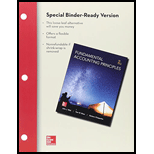
Loose Leaf for Fundamentals of Accounting Principles and Connect Access Card
22nd Edition
ISBN: 9781259542169
Author: John J Wild
Publisher: McGraw-Hill Education
expand_more
expand_more
format_list_bulleted
Concept explainers
Textbook Question
Chapter 11, Problem 1QS
Classifying liabilities
C1
Which of the following items are normally classified as current liabilities for a company that has a 15-month operating cycle?
______1. Portion of long-term note due in 15 months.
______2. Note payable maturing in 2 years.
______3. Note payable due in 18 months.
______4. Note payable due in 11 months.
______5. FICA taxes payable.
______6. Salaries payable.
Expert Solution & Answer
Want to see the full answer?
Check out a sample textbook solution
Students have asked these similar questions
Please correct answer
I need help with accounting question
Don't use ai to answer I will report you answer
Chapter 11 Solutions
Loose Leaf for Fundamentals of Accounting Principles and Connect Access Card
Ch. 11 - Prob. 1DQCh. 11 - Prob. 2DQCh. 11 - What are the three important questions concerning...Ch. 11 - Prob. 4DQCh. 11 - Prob. 5DQCh. 11 - Prob. 6DQCh. 11 - Prob. 7DQCh. 11 - Prob. 8DQCh. 11 - Prob. 9DQCh. 11 - Prob. 10DQ
Ch. 11 - Prob. 11DQCh. 11 - Prob. 12DQCh. 11 - Prob. 13DQCh. 11 - Prob. 14DQCh. 11 - Prob. 15DQCh. 11 - Prob. 16DQCh. 11 - Prob. 17DQCh. 11 - Classifying liabilities C1 Which of the following...Ch. 11 - Prob. 2QSCh. 11 - Prob. 3QSCh. 11 - Prob. 4QSCh. 11 - Prob. 5QSCh. 11 - Prob. 6QSCh. 11 - Prob. 7QSCh. 11 - Prob. 8QSCh. 11 - Prob. 9QSCh. 11 - Prob. 10QSCh. 11 - Prob. 11QSCh. 11 - Prob. 12QSCh. 11 - Prob. 13QSCh. 11 - Prob. 14QSCh. 11 - Prob. 1ECh. 11 - Prob. 2ECh. 11 - Prob. 3ECh. 11 - Prob. 4ECh. 11 - Prob. 5ECh. 11 - Prob. 6ECh. 11 - Prob. 7ECh. 11 - Prob. 8ECh. 11 - Prob. 9ECh. 11 -
Hitzu Co. sold a copier costing S4.800 with a...Ch. 11 - Prob. 11ECh. 11 - Prob. 12ECh. 11 - Prob. 13ECh. 11 - Prob. 14ECh. 11 - Prob. 15ECh. 11 - Prob. 16ECh. 11 - Prob. 17ECh. 11 - Prob. 18ECh. 11 - Prob. 1APSACh. 11 - Prob. 2APSACh. 11 - Prob. 3APSACh. 11 - Prob. 4APSACh. 11 - Prob. 5APSACh. 11 - Prob. 6APSACh. 11 - Problem 11-1B Short-term notes payable...Ch. 11 - Prob. 2BPSBCh. 11 - Prob. 3BPSBCh. 11 - Prob. 4BPSBCh. 11 - Prob. 5BPSBCh. 11 - Prob. 6BPSBCh. 11 - Prob. 11SPCh. 11 - Prob. 11CPCh. 11 - Prob. 1GLPCh. 11 - Prob. 1BTNCh. 11 - Prob. 2BTNCh. 11 - Prob. 3BTNCh. 11 - Prob. 4BTNCh. 11 - Prob. 5BTNCh. 11 - Prob. 6BTNCh. 11 - Prob. 7BTNCh. 11 - Prob. 8BTNCh. 11 - Prob. 9BTN
Knowledge Booster
Learn more about
Need a deep-dive on the concept behind this application? Look no further. Learn more about this topic, accounting and related others by exploring similar questions and additional content below.Similar questions
- Choice correct answer is accountingarrow_forwardAnsarrow_forward1. Armor Company had the following information for the month of December. All direct materials were one hundred percent complete, and beginning materials cost $22,700. Work in Process Inventory Beginning balance @ 12/1: 420 units, 10% completed $ 26,000 Completed 1,050 units and transferred them to finished goods inventory $ 217,291 Direct materials 74,000 Direct labor 50,000 Overhead Property taxes 16,000 Depreciation 47,000 Utilities 31,000 Indirect labor 14,000 Ending balance @ 12/31: 405 units, 20% completed $ 40,709 Cost per equivalent unit for conversion under the FIFO method is calculated to be (rounded): 2. Shyne Incorporated calculates cost for an equivalent unit of production using the weighted-average method. Data for July: Work-in-process inventory, July 1 (38,000 units): Direct materials (96% completed) $ 122,600 Conversion (54% completed) 77,050 Balance in work in process inventory, July 1 $ 199,650 Units…arrow_forward
arrow_back_ios
SEE MORE QUESTIONS
arrow_forward_ios
Recommended textbooks for you
- Principles of Accounting Volume 1AccountingISBN:9781947172685Author:OpenStaxPublisher:OpenStax College

Principles of Accounting Volume 1
Accounting
ISBN:9781947172685
Author:OpenStax
Publisher:OpenStax College
Chapter 19 Accounting for Income Taxes Part 1; Author: Vicki Stewart;https://www.youtube.com/watch?v=FMjwcdZhLoE;License: Standard Youtube License